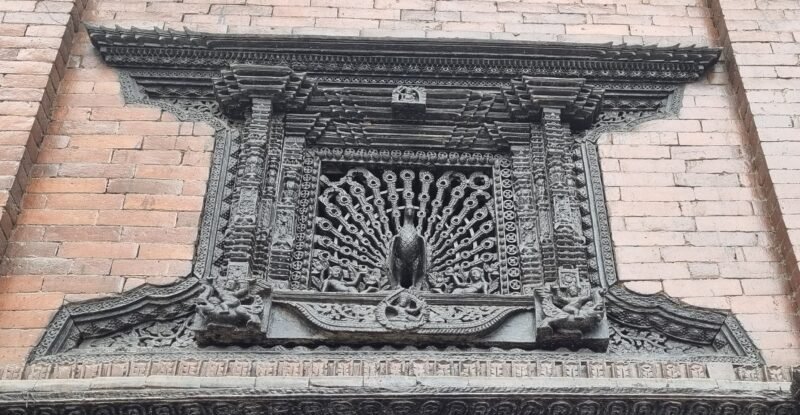No products in the cart.

Ankhi Jhyal is typical Nepalese window. “Ankhi Jhyal” is a term that refers to a traditional architectural feature commonly found in Newar houses in Nepal. It translates to “eye window” in English.
The Newar people are an ethnic group native to the Kathmandu Valley in Nepal, known for their rich cultural heritage and distinct architectural style. The Ankhi Jhyal is a characteristic window design that is often seen on the upper floors of traditional Newar houses.
The Ankhi Jhyal window is typically small and rectangular in shape, resembling an eye. It is intricately carved and decorated, showcasing the fine craftsmanship of the Newar artisans. These windows serve both functional and symbolic purposes. They allow natural light and ventilation into the house while providing privacy to the occupants. The window design is also considered auspicious and is believed to ward off evil spirits.
The Ankhi Jhyal is a significant element of Newar architecture and reflects the cultural identity and artistic traditions of the Newar community in Nepal. It is perfect example of wood carving from Nepal.
This type of windows was used in traditional houses in Kathmandu Valley, capital city of Nepal. Ankhi Jhyal still can be seen in old houses in the city. It can be profoundly found in Kathmandu Durbar Square, Patan Durbar Square and Bhaktapur Durbar Square. These squares are traditional empire states, listed in world heritage sites and complex of temples, traditional buildings and monuments.
Ankhi Jhyal is part of traditional architecture from Nepal. It is widely believed that Ankhi Jhyal developed for two reasons; first there were no other material to use in window like grills and glass for safety and it is made out of woods only. Second, it is beautiful, strong for safety and better way of expression of art.
Nowadays, Ankhi Jhyal is rarely used as real window. More commonly it is using as interior decoration of house. Ankhi Jhyal are being made from small to big one. Though, use of this window almost extinguished from normal use as window, it is widely preferred item for interior of houses. It has been developing as symbol of luxury.
To prepare an Ankhi Jhyal from wood, it requires special type of wood carving skill, takes long time and obviously, expensive. As other materials developed and became common to use as real windows of building, it is replaced for using as real window (Jhyal). It took the place of decoration and made in verities of sizes.

History of Ankhi Jhyal
The Ankhi Jhyal, or eye window, has a rich history rooted in the architectural traditions of the Newar people in Nepal. The Newars have a long history of craftsmanship and artistry, and their architectural designs are influenced by a blend of Hindu, Buddhist, and indigenous beliefs.
The exact origin and early history of the Ankhi Jhyal are not well-documented. However, it is believed that this distinctive window design emerged during the medieval period when the Newar civilization flourished in the Kathmandu Valley. The Newar people have a tradition of constructing beautifully carved windows, doors, and other architectural elements, and the Ankhi Jhyal became one of their iconic features.
The Newar architecture is characterized by intricate woodcarvings, which are often seen in their windows, columns, and doorways. The Ankhi Jhyal window represents the artistic and cultural heritage of the Newar community. It reflects the Newar people’s reverence for nature, their religious beliefs, and their aesthetic sensibilities.
In addition to its aesthetic appeal, the Ankhi Jhyal serves functional purposes as well. The small size and unique shape of the window allow for privacy while enabling the entry of natural light and ventilation. It is also believed to act as a protective barrier against evil spirits, as the window resembles a vigilant eye.
Over time, the Ankhi Jhyal has become an iconic symbol of Newar architecture and is widely recognized as a significant cultural element in Nepal. It continues to be an integral part of traditional Newar houses and is appreciated for its craftsmanship, symbolism, and historical significance.
Types
The Ankhi Jhyal, or eye window, in Nepal can come in various types and designs, each with its unique characteristics. Here are a few common types of Ankhi Jhyal found in traditional Newar architecture:
- Simple Rectangular Ankhi Jhyal: This is the most basic and common type of Ankhi Jhyal. It features a small rectangular window with intricately carved wooden latticework. The window is often adorned with floral or geometric patterns, showcasing the craftsmanship of Newar artisans.
- Peacock Ankhi Jhyal: This type of Ankhi Jhyal incorporates the image of a peacock within its design. The peacock, a revered symbol in Hindu and Buddhist traditions, is intricately carved into the window frame. The peacock motif adds a touch of elegance and symbolism to the window.
- Elephant Ankhi Jhyal: The elephant Ankhi Jhyal showcases the image of an elephant within its design. Elephants hold cultural and religious significance in Nepal and are considered auspicious. The window incorporates intricate elephant carvings, representing strength, wisdom, and good fortune.
- Floral Ankhi Jhyal: This type of Ankhi Jhyal prominently features floral motifs and designs. The window is adorned with intricate carvings of various flowers and leaves, creating a visually appealing and naturalistic design. Floral Ankhi Jhyal represents the beauty of nature and is often associated with prosperity and abundance.
- Shikhar Ankhi Jhyal: The Shikhar Ankhi Jhyal has a distinct shape resembling the traditional temple spire, or shikhar. It features multiple levels of carved wooden latticework, creating a tiered and elaborate design. The Shikhar Ankhi Jhyal is particularly seen in larger and more elaborate Newar houses or buildings.
These are just a few examples of the types of Ankhi Jhyal found in Nepal. The specific designs and motifs may vary depending on the region, the preferences of the household, and the skill of the artisans involved. The variety in Ankhi Jhyal designs reflects the creativity, cultural significance, and artistic diversity of Newar architecture in Nepal.
Importance
The Ankhi Jhyal, or eye window, holds great importance in the context of Newar architecture and culture in Nepal. Here are some key aspects that highlight its significance:
- Cultural Identity: The Ankhi Jhyal is a distinct architectural feature that is closely associated with the Newar community. It represents the cultural identity and artistic traditions of the Newar people, who have a rich heritage in the Kathmandu Valley. It serves as a visual representation of their unique craftsmanship and architectural style.
- Symbolism: The window’s design, resembling an eye, carries symbolic meaning. It is believed to protect the house and its inhabitants from evil spirits, serving as a watchful eye. The symbolic aspect of the Ankhi Jhyal reflects the spiritual beliefs and rituals practiced by the Newar community.
- Aesthetics and Craftsmanship: The Ankhi Jhyal is highly admired for its intricate woodcarvings and delicate detailing. It showcases the exceptional craftsmanship and artistic skills of Newar artisans. The window adds beauty and elegance to the overall architectural composition of traditional Newar houses.
- Functionality: The Ankhi Jhyal serves practical purposes as well. Despite its small size, it allows natural light to enter the rooms, creating a well-lit and pleasant environment. Additionally, the window design enables ventilation, helping to maintain a comfortable indoor climate.
- Preservation of Heritage: The Ankhi Jhyal, along with other architectural elements of Newar houses, contributes to the preservation of Nepal’s cultural heritage. By maintaining and valuing these traditional features, the Newar community and society at large can ensure the continuity of their architectural legacy and pass it on to future generations.
Overall, the Ankhi Jhyal holds significance as a cultural symbol, a testament to craftsmanship, and a reminder of the rich cultural heritage of the Newar people in Nepal. It represents the intersection of aesthetics, functionality, and spirituality, making it an integral part of traditional Newar architecture.
Usages
The Ankhi Jhyal, or eye window, in Nepal has several usages within the context of traditional Newar architecture. Here are some common purposes and functions associated with the Ankhi Jhyal:
- Natural Light and Ventilation: The small size and strategic placement of the Ankhi Jhyal allow natural light to enter the rooms. It helps illuminate the interior spaces of the house, reducing the reliance on artificial lighting during the daytime. Additionally, the window design facilitates cross-ventilation, promoting airflow and maintaining a comfortable indoor environment.
- Privacy: The Ankhi Jhyal is designed in a way that provides privacy to the occupants while allowing light to enter. The intricately carved wooden latticework allows a limited view from the inside, while the small size and decorative patterns restrict visibility from the outside. This feature ensures privacy for the residents without compromising on the benefits of natural light and ventilation.
- Symbolic Protection: The Ankhi Jhyal carries symbolic significance in Newar culture. It is believed to act as a protective barrier against evil spirits and negative energy. The window, resembling a vigilant eye, is thought to ward off evil and bring positive vibes into the house. It serves as a spiritual symbol of safeguarding the home and its inhabitants.
- Architectural Beauty: The Ankhi Jhyal is an ornamental element that adds aesthetic value to traditional Newar houses. The intricate woodcarvings, delicate patterns, and unique shape of the window contribute to the overall beauty and elegance of the architectural design. It showcases the craftsmanship and artistic skills of Newar artisans.
- Cultural Identity: The usage of Ankhi Jhyal in the architecture of Newar houses represents the cultural identity of the Newar community. It is an important symbol of their heritage, distinguishing their architectural style from other regions and communities. The inclusion of Ankhi Jhyal in the design of a house signifies a connection to Newar culture and traditions.
Overall, the Ankhi Jhyal serves both functional and symbolic purposes in traditional Newar architecture. It allows natural light and ventilation while providing privacy to the occupants. Its ornamental design adds beauty to the house and reflects the cultural identity of the Newar community in Nepal.



